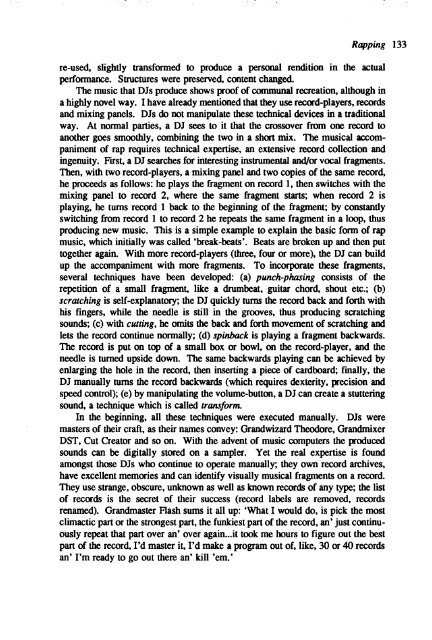1991 No. 1 CONTENTS - Institute of Social and Cultural ...
1991 No. 1 CONTENTS - Institute of Social and Cultural ...
1991 No. 1 CONTENTS - Institute of Social and Cultural ...
Create successful ePaper yourself
Turn your PDF publications into a flip-book with our unique Google optimized e-Paper software.
Rapping 133<br />
re-used, slightly transformed to produce a personal rendition in the actual<br />
perfonnance. Structures were preserved, content changed.<br />
The music that DJs produce shows pro<strong>of</strong> <strong>of</strong> communal recreation, although in<br />
a highly novel way. I have already mentioned that they use record-players, records<br />
<strong>and</strong> mixing panels. DJ s do not manipulate these technical devices in a traditional<br />
way. At nonnal parties, a DJ sees to it that the crossover from one record to<br />
another goes smoothly, combining the two in a short mix. The musical accompaniment<br />
<strong>of</strong> rap requires technical expertise, an extensive record collection <strong>and</strong><br />
ingenuity. First, a DJ searches for interesting instrumental <strong>and</strong>/or vocal fragments.<br />
Then, with two record-players, a mixing panel <strong>and</strong> two copies <strong>of</strong> the same record,<br />
he proceeds as follows: he plays the fragment on record 1, then switches with the<br />
mixing panel to record 2,where the same fragment starts; when record 2 is<br />
playing, he turns record 1 back to the beginning <strong>of</strong> the fragment; by constantly<br />
switching from record 1 to record 2 he repeats the same fragment in a loop, thus<br />
producing new music. This is a simple example to explain the basic fonn <strong>of</strong> rap<br />
music, which initially was called 'break-beats'. Beats are broken up <strong>and</strong> then put<br />
together again. With more record-players (three, four or more), the DJ can build<br />
up the accompaniment with more fragments. To incorporate these fragments,<br />
several techniques have been developed: (a) punch-phasing consists <strong>of</strong> the<br />
repetition <strong>of</strong> a small fragment, like a drumbeat, guitar chord, shout etc.; (b)<br />
scratching is self-explanatory; the DJ quickly turns the record back <strong>and</strong> forth with<br />
his fingers, while the needle is still in the grooves, thus producing scratching<br />
sounds; (c) with cUlting, he omits the back <strong>and</strong> forth movement <strong>of</strong> scratching <strong>and</strong><br />
lets the record continue normally; (d) spinback is playing a fragment backwards.<br />
The record is put on top <strong>of</strong> a small box or bowl, on the record-player, <strong>and</strong> the<br />
needle is turned upside down. The same backwards playing can be achieved by<br />
enlarging the hole in the record, then inserting a piece <strong>of</strong> cardboard; fmally, the<br />
DJ manually turns the record backwards (which requires dexterity, precision <strong>and</strong><br />
speed control); (e) by manipulating the volume-button, a DJ can create a stuttering<br />
sound, a technique which is called transform.<br />
In the beginning, all these techniques were executed manUally. DJs were<br />
masters <strong>of</strong> their craft, as their names convey: Gr<strong>and</strong>wizard Theodore, Gr<strong>and</strong>mixer<br />
DST, Cut Creator <strong>and</strong> so on. With the advent <strong>of</strong> music computers the produced<br />
sounds can be digitally stored on a sampler. Yet the real expertise is found<br />
amongst those DJs who continue to operate manually; they own record archives,<br />
have excellent memories <strong>and</strong> can identify visually musical fragments on a record.<br />
They use strange, obscure, unknown as well as known records <strong>of</strong> any type; the list<br />
<strong>of</strong> records is the secret <strong>of</strong> their success (record labels are removed, records<br />
renamed). Gr<strong>and</strong>master Flash sums it all up: 'What I would do, is pick the most<br />
climactic part or the strongest part, the funkiest part <strong>of</strong> the record, an' just continuously<br />
repeat thal part over an' over again .. .il took me hours to figure oul the best<br />
part <strong>of</strong> the record, I'd master it, I'd make a program out <strong>of</strong>, like, 30 or 40 records<br />
an' I'm ready to go out there an' kill 'em.'
















